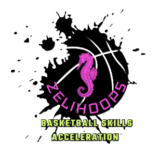When it comes to shooting a basketball, the foundation of your success lies in your stance. Two of the most commonly debated shooting stances are:
- Ten toes facing the basket
- Feet slightly tilted
Each stance has its advantages, and finding the one that works best for you depends on your natural mechanics, comfort level, and shooting consistency. In this blog, we’ll explore the key differences between these two stances, the arguments for each, and examples of NBA players who have thrived using them.
Ten Toes Facing the Basket
In this stance, both of your feet are squared up to the basket, with your toes pointing directly toward it. The idea behind this stance is that by aligning your entire body—feet, hips, and shoulders—with the target, you maximize balance and shooting accuracy.
Arguments For This Stance:
- Better Alignment: Keeping your toes, hips, and shoulders square to the basket creates a straight shooting line. This stance minimizes the need for compensatory adjustments in your shot mechanics.
- Simplicity: This stance is easy to teach and provides a straightforward foundation for players learning how to shoot.
- Consistency: For players who rely heavily on muscle memory, this stance can feel more repeatable because of its focus on straight alignment.
Arguments Against This Stance:
- Limited Natural Flow: Some players feel restricted in this stance because it can force their shooting arm into an uncomfortable position, particularly if they have a naturally tilted release.
- Lower Body Strain: For certain body types, squaring up completely may feel unnatural and lead to inconsistencies.
Example of an NBA Player:
- Ray Allen: Known as one of the greatest shooters in NBA history, Allen often employed the “ten toes facing the basket” stance. His textbook form and alignment contributed to his legendary accuracy.
Feet Slightly Tilted
In this stance, your feet are angled slightly away from the basket, often pointing toward the non-shooting side (e.g., for a right-handed shooter, feet may point slightly to the left). This stance is more about comfort and allowing the natural alignment of the body to dictate shot mechanics.
Arguments For This Stance:
- Natural Flow: Tilting the feet allows the hips and shoulders to align more comfortably with the shooting arm, creating a smoother release.
- Reduced Tension: This stance often feels less restrictive, particularly for players with a natural shooting arm tilt.
- Adaptability: Many players find this stance more versatile in dynamic situations, such as shooting off the dribble or while on the move.
Arguments Against This Stance:
- Potential Inconsistency: A slight tilt can sometimes lead to an over-rotation of the shoulders, which may affect accuracy if not executed properly.
- Learning Curve: For beginners, this stance may be harder to teach and master because it requires more individual adjustments.
Example of an NBA Player:
- Stephen Curry: Regarded as the greatest shooter of all time, Curry often uses a slightly tilted stance. His comfort with this alignment helps him achieve his lightning-quick release and unparalleled shooting consistency.
How to Find the Best Stance for You
Deciding between these two stances comes down to personal preference and experimentation. Here are a few steps to help you determine which stance suits you best:
- Analyze Your Natural Mechanics: Take some time to shoot in both stances during practice. Pay attention to which one feels more comfortable and produces better results.
- Work With a Coach: A trained eye can spot mechanical issues and recommend a stance that aligns with your body’s natural tendencies.
- Track Your Shooting Percentage: Practice shooting a set number of shots (e.g., 50 or 100) using each stance. Compare your makes and misses to see which stance yields higher accuracy.
- Consider Game Scenarios: Test both stances in game-like situations, such as shooting off the dribble or in catch-and-shoot scenarios, to see which feels more effective under pressure.
The Bottom Line
Both stances have their merits, and neither is definitively better than the other. What matters most is finding the stance that feels natural, minimizes tension, and maximizes consistency in your shooting mechanics. As demonstrated by players like Ray Allen and Stephen Curry, great shooters can thrive using either approach.
Take the time to experiment, gather data, and fine-tune your stance to fit your game. Once you find the stance that works for you, commit to it, and watch your shooting percentage soar.
